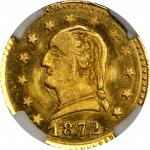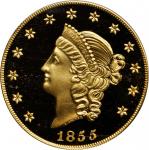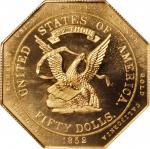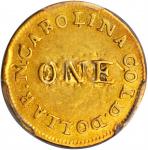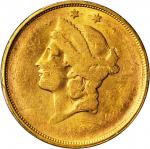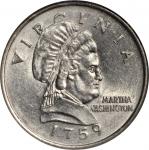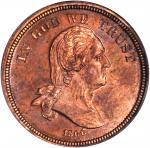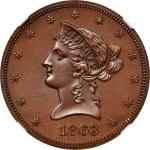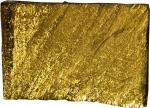Cut Portion of Kellogg & Humbert Assayers Gold Ingot No. 757. 11.3 ounces. 907 fine.Approximately 51 mm x 12 mm x 29 mm. This is one of the most exciting and interesting gold ingots recovered from the <em>S.S. Central America</em> that we have ever brought to auction. Actually a cut portion of a much larger ingot (see below), this piece is bright medium gold with original surfaces present along the face, back, and right edge. Those surfaces have the generally smooth texture characteristic of many California Gold Rush ingots, with the numerous tiny marks and other imperfections (as made) that make each of these a truly unique piece of history. The face displays the only clues that have allowed researchers to ascertain that this portion was cut from Kellogg & Humbert ingot No. 757. Present is much of the stamped makers mark, the word KELLOGG complete save for the top of each letter, the & complete, and the word HUMBERT complete save for the bottom of the letter H. The top of the letters SAY in ASSAYERS are barely discernible, and also present is a portion of the right frame line of the stamp. Obviously the maker of this ingot is evident, but how do we know that it is ingot No. 757? A tiny dimple immediately to the right of the & and another, slightly larger one approximately halfway between the frame line of the stamp and the ingots right edge are the keys. Unique to this ingot, these two dimples correspond to those seen on the image of Kellogg & Humbert ingot No. 757 on page 454 in the 2002 book <em>A California Gold Rush History</em> by Q. David Bowers.<p>Ingot No. 757 was one of the larger Kellogg & Humbert ingots recovered from the <em>S.S. Central America</em> treasure, assigned to Mold KH-06 in the aforementioned Bowers reference. The entire ingot weighed 254.75 troy ounces with a contemporary face value of $4,776.40 based on a gold price of $20.67 per troy ounce.<p>The top, bottom, and left edge of this cut portion are also fairly smooth to the touch with a similarly bright medium gold color to the original surface areas, but they display numerous fine grooves from when the ingot was cut (more accurately sawed) down. Deeper grooves are noted along the top edge of the face and at the lower left corner (relative to the face) below the letters HU in HUMBERT. The circumstances that led to this ingot being cut down in this fashion are interesting and enhance its desirability as a valuable piece of California Gold Rush history.<p>The story of this ingot begins in San Francisco during the California Gold Rush. The assaying firm of Kellogg & Humbert was founded in 1855 as the product of several mergers between prominent regional gold firms. Before long, their assayed bars gained acclaim and were popular in the metropolises of New York City and London, even being utilized by the United States Mint in Philadelphia. Monthly shipments delivered this gold to eastern destinations via steamers to Panama, where the newly constructed Panama Railroad would then transport cargo and passengers for the four-hour, 48-mile journey across the isthmus to the Atlantic coast for transit elsewhere.<p>At least 343 ingots of California gold made this journey in late August of 1857. While the first leg of the voyage from San Francisco to Panama aboard the <em>S.S. Sonora</em> was unremarkable, the same, unfortunately, cannot be said about the remainder of the trip. After departing the Panamanian port of Colon, then known as Aspinwall, and making a brief stop in Havana, Cuba, the <em>S.S. Central America</em> steamed towards New York City with an estimated 597 passengers and crew and a cargo of over $1.2 million in registered treasure, Kellogg & Humbert ingot No. 757 included. On Friday, September 11, 1857, a hurricane resulted in flooding that became too much for the pair of coal-powered steam engines, rendering the vessel unable to pump out incoming water and left at the mercy of the tumultuous Atlantic Ocean. After floundering and listing for more than a day off the coast of the Carolinas, the ship disappeared beneath the waves shortly after 8 pm on Friday the 12th, claiming the lives of over 400 individuals and plunging its glistening cargo nearly one and a half miles to the ocean floor.<p>Lurking in the depths for more than 130 years, the wreckage of the <em>S.S. Central America</em> would remain undisturbed until its discovery on September 11, 1988, causing considerable excitement among the numismatic, maritime, and treasure-hunting communities around the world. Preserved by the frigid and tranquil environment of the sea floor, the sunken treasure remained largely untroubled and required little conservation to be brought back to virtually pristine condition.<p>The ingots and coins recovered from the <em>S.S. Central America</em> shipwreck have since been widely dispersed, with many examples in the hands of private collectors. Kellogg & Humbert ingot No. 757 was once owned by Hall of Fame basketball legend Karl Malone, who spent much of his 19-year career with the Utah Jazz before playing his final season (2003-2004) with the Los Angeles Lakers. After retiring from the NBA, Mr. Malone coached for the Louisiana Tech Bulldogs basketball team from 2007 to 2011. He was inducted into the Naismith Memorial Basketball Hall of Fame in 2010. Earlier in his career, Mr. Malone competed with the United States national basketball team at the 1992 and 1996 Summer Olympic Games, winning gold medals both years.<p>In August of 2009 the cut portion of ingot No. 757 offered here was on display at the table of a California coin dealer during the ANA Worlds Fair of Money in Los Angeles. Capturing the attention of Adam Crum and Neil Sharkey of Monaco Financial, major marketers of the <em>S.S. Central America</em> treasure, the full modern story of this ingot then became known. After plate matching this cut portion of Kellogg & Humbert ingot No. 757 in the Bowers reference and determining that that ingot was once owned by Karl Malone, Crum and Skarkey contacted Mr. Malones agent and learned that his ingots had been stolen and presumed to have been melted. The existence and condition of the present cut portion, however, confirms that ingot No. 757 was cut into many smaller pieces, presumably as a division of the stolen treasure among the thieves. One of the perpetrators was eventually identified and, since Mr. Malone decided not to press charges, the ownership of this cut portion is free of encumbrances.<p>After its theft and cutting down from its parent ingot, this piece was sold to a pawn shop in Mississippi, then to a Texas coin dealer, and finally to the California dealer who had it on display at the August 2009 ANA Worlds Fair of Money. Acquired by Monaco Financial, this cut portion was then sold to the present consignor. It is a desirable, historic piece with an indelible link to the California Gold Rush, as well as part of a fascinating modern story through its former ownership by NBA legend Karl Malone. California Gold Rush enthusiasts and other advanced collectors are urged to enter the strongest bids for this remarkable item.<p>This lot includes a letter dated December 19, 2012, from Robert D. Evans, chief scientist and historian of the <em>S.S. Central America</em> project, that describes the history of this cut ingot portion from its creation during the California Gold Rush all the way up to its identification and link to Karl Malone by Monaco Financial. The two-page letter is typed on Mr. Evans personal letterhead. <strong><em>The letter is available to the winning bidder upon request to Stacks Bowers Galleries at the close of the auction</em></strong>.Ex <em>S.S. Central America</em>; Hall of Fame basketball legend Karl Malone; unknown intermediaries; Mississippi pawn shop; Texas coin dealer; California coin dealer, displayed at the August 2009 ANA Worlds Fair of Money in Los Angeles; Monaco Financial; the present consignor.



